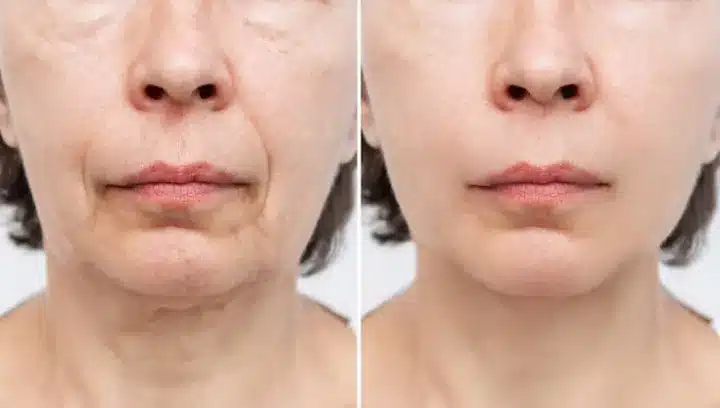Face surgery side effects encompass a range of potential complications and adverse events that individuals considering such procedures should understand. From common occurrences like swelling and bruising to more serious complications, such as nerve damage or infection, awareness of these risks is crucial for informed decision-making. Understanding the nuances of these side effects empowers patients to collaborate effectively with their surgeons in optimizing safety and achieving desired aesthetic outcomes.
Facial surgery
Face surgery, also known as facial plastic surgery or cosmetic facial surgery, is a branch of plastic surgery that focuses on enhancing or altering the appearance of the face. It is a popular option for individuals seeking to address various aesthetic concerns or improve facial features.
Face surgery can range from minimally invasive treatments to more complex surgical interventions. While these procedures offer the potential for transformative results, it is essential to consider their potential side effects and associated risks. In this article, we will explore factors of the face surgery side effects and Face surgery side effects.
Cosmetic face surgery encompasses a variety of procedures tailored to enhance facial aesthetics and improve self-confidence. Among these, Rhinoplasty, or nose reshaping, and Blepharoplasty, targeting the eyelids, are highly sought for their ability to harmonize facial features and rejuvenate the eyes, respectively.
Facial surgery, also known as facial plastic surgery or cosmetic surgery, refers to surgical procedures aimed at improving the appearance of the face. These procedures can range from subtle enhancements to significant transformations, depending on the individual’s goals and needs. Some common facial surgeries include:
Clinic contact number: +989371200167
- Rhinoplasty (nose job)
This procedure involves reshaping the nose to improve its appearance and/or function.
- Blepharoplasty (eyelid surgery)
It focuses on rejuvenating the appearance of the eyelids by removing excess skin, fat, or muscle.
- Facelift
This surgery aims to tighten and lift sagging facial tissues, providing a more youthful appearance.
- Brow lift
Also known as a forehead lift, it involves lifting the brow area to reduce wrinkles and lines, and to create a more youthful appearance.
Factors of face surgery side effects
The severity and specific side effects of face surgery can depend on several factors, including:
Type of Procedure
Different types of face surgery can have varying side effects. For example, procedures like rhinoplasty (nose job) or blepharoplasty (eyelid surgery) may have specific side effects related to the treated area.
here are some specific types of facial procedures:
Rhinoplasty (Nose Job)
This surgery involves reshaping the nose to improve its appearance or function. It can address issues such as size, shape, symmetry, or breathing difficulties.
Blepharoplasty (Eyelid Surgery)
This procedure focuses on rejuvenating the appearance of the eyelids by removing excess skin, fat, or muscle. It can help reduce puffiness, drooping eyelids, and under-eye bags.
Facelift (Rhytidectomy)
Facelift surgery aims to tighten and lift sagging facial tissues, particularly in the lower face and neck. It can address wrinkles, jowls, and loose skin, providing a more youthful appearance.
Individual Factors
Each person’s body and healing process can vary. Factors such as age, overall health, skin type, and genetic predispositions can influence how an individual responds to surgery and the subsequent side effects.
Surgical Technique
The surgical technique used by the surgeon can impact side effects. Advanced techniques and approaches can help minimize certain side effects and improve outcomes.
Surgeon’s Skill and Experience
The skill and experience of the surgeon performing the procedure play a crucial role in minimizing side effects. An experienced and qualified surgeon can employ techniques that reduce the risk of complications and optimize results.
Preoperative and Postoperative Care
Following preoperative and postoperative care instructions is essential for minimizing side effects. Proper wound care, medication adherence, and regular follow-up appointments contribute to a smoother recovery.
Patient Compliance
Patient compliance with postoperative instructions, including maintaining a healthy lifestyle, avoiding tobacco and alcohol, and protecting the surgical site from trauma or excessive sun exposure, can influence the occurrence and severity of side effects.
Clinic contact number: +989371200167
Mitigating Risks and Maximizing Results through Collaborative Efforts
In the realm of facial plastic surgery, where precision and artistry converge, understanding the nuances of potential side effects is paramount. Renowned institutions such as Johns Hopkins University School of Medicine and the Stanford University School of Medicine have conducted extensive research into the intricacies of facial surgery side effects. Pioneering figures like Dr. Sherrell Aston, known for his contributions to the field of aesthetic surgery, have elucidated the complex interplay between surgical techniques and postoperative outcomes.
Moreover, institutions like the Mayo Clinic, with its multidisciplinary approach to patient care, have been instrumental in disseminating knowledge about mitigating adverse events in facial surgery. Within the landscape of facial surgery, companies like Allergan, a global leader in medical aesthetics, and hospitals like Massachusetts General Hospital have emerged as frontrunners in innovation and patient care. Their collaborative efforts have yielded groundbreaking advancements in surgical technologies and postoperative protocols aimed at minimizing side effects and optimizing patient satisfaction.
Recent statistics reveal a notable surge in the demand for facial procedures, with a reported 5% increase in rhinoplasty and a 7% rise in facelift surgeries in the past year alone. This burgeoning trend underscores the growing importance of comprehensive preoperative assessment and meticulous intraoperative technique to mitigate the risk of adverse events in the ever-evolving landscape of facial surgery.

Face surgery side effects
While face surgery can produce remarkable results, being aware of potential side effects is important. Not all individuals will experience these side effects, and their severity can vary depending on the procedure and individual factors. Here are 15 potential side effects associated with face surgery:
- Pain and Discomfort: Following face surgery, patients may experience pain, discomfort, or tightness in the treated area. This is typically managed with prescribed pain medication.
- Swelling: Swelling is a common side effect after face surgery and can persist for several weeks. It is a natural part of the healing process and gradually subsides over time.
- Bruising: Bruising around the surgical site is another common side effect. It typically resolves within a few weeks but may require makeup or concealer to camouflage during the initial recovery period.
- Scarring: Depending on the procedure, scarring may occur. Surgeons aim to minimize visible scarring by placing incisions strategically and utilizing advanced techniques. However, individual healing processes can vary, and some scarring may be inevitable.
- Numbness: Temporary or permanent numbness may occur in the treated area due to nerve manipulation during surgery. The sensation typically returns gradually, but it may take several months.
- Infection: Although rare, infection can occur following any surgical procedure. Patients are typically prescribed antibiotics and provided with post-operative care instructions to minimize this risk.
- Bleeding: Some bleeding or oozing is normal immediately after surgery. However, excessive or prolonged bleeding should be reported to the surgeon promptly.
- Skin Discoloration: Temporary skin discoloration or changes in pigmentation may occur, especially with procedures like laser resurfacing. These usually fade over time but may require additional treatment or camouflage in some cases.
- Asymmetry: Despite the surgeon’s best efforts, slight asymmetry may occur following facial surgery. In most cases, it is minor and not noticeable to others. However, significant asymmetry may require further correction.
- Nerve Damage: Facial surgery involves delicate structures, and there is a small risk of nerve damage. This can lead to temporary or, rarely, permanent weakness, numbness, or muscle dysfunction in the treated area.
- Hairline Changes: Certain procedures, such as facelifts or brow lifts, may result in subtle changes to the hairline. These changes are carefully planned and discussed with the patient before surgery.
- Eye Irritation: Procedures involving the eyelids, such as blepharoplasty, may cause temporary dryness, itchiness, or sensitivity in the eyes. Eye drops or ointments can help alleviate these symptoms.
- Difficulty Speaking or Smiling: Swelling and muscle tightness after facial surgery may temporarily affect speech and facial expressions. These effects subside as healing progresses.
- Allergic Reactions: In rare cases, individuals may experience an allergic reaction to medications, dressings, or other substances used during or after surgery. Immediate medical attention should be sought if severe allergic reactions occur.
- Psychological Impact: While not a physical side effect, it is important to acknowledge that face surgery can have psychological effects. Managing expectations, addressing body image concerns, and seeking support from loved ones or professionals can help navigate the emotional aspects of the process.
The potential for nerve damage is present in many different types of surgical procedures. Numbness and tingling are common after plastic surgery and can be signs of nerve damage. American Society of Plastic Surgeons
Conclusion
In conclusion, while the prospect of face surgery holds promise for transformative outcomes, it is essential to acknowledge and address the potential side effects and complications that may arise. From common occurrences such as swelling and bruising to more complex issues like seromas, hypertrophic scars, and keloids, understanding these adverse events is paramount for both patients and surgeons.
By prioritizing meticulous surgical techniques, adhering to comprehensive postoperative care plans, and maintaining open communication throughout the process, individuals can mitigate the risk of adverse events and optimize their surgical experience. Moreover, ongoing research and advancements in surgical approaches aim to further minimize the occurrence of these side effects, ultimately ensuring safer and more satisfactory outcomes for individuals undergoing facial procedures.
Clinic contact number: +989371200167

FAQs:
What are the common Face surgery side effects?
Common Face surgery side effects include pain, swelling, bruising, scarring, numbness, infection, bleeding, skin discoloration, asymmetry, and…
Are side effects the same for all types of face surgery?
While some Face surgery side effects may be shared across different types of face surgery, the severity and specific side effects can vary depending on the procedure performed.
Is pain common after facial surgery?
Some discomfort or mild pain is typical after facial surgery, which can be managed with prescribed pain medications. Most patients find that the discomfort improves significantly within the first week post-surgery.
Will there be scars after facial surgery?
Scarring is inevitable with any surgical procedure, but the extent and visibility of scars vary depending on factors such as surgical technique, incision placement, and individual healing. Skilled surgeons strive to minimize scarring and often place incisions in inconspicuous areas whenever possible.
When can I expect to see the final results of facial surgery?
The timeline for final results varies depending on the procedure performed. In general, visible improvements may be noticeable as swelling and bruising subside over several weeks. However, it can take several months for the full results to become apparent as the tissues fully heal and settle.
Facelift Risks and Safety | American Society of Plastic Surgeons (plasticsurgery.org)



